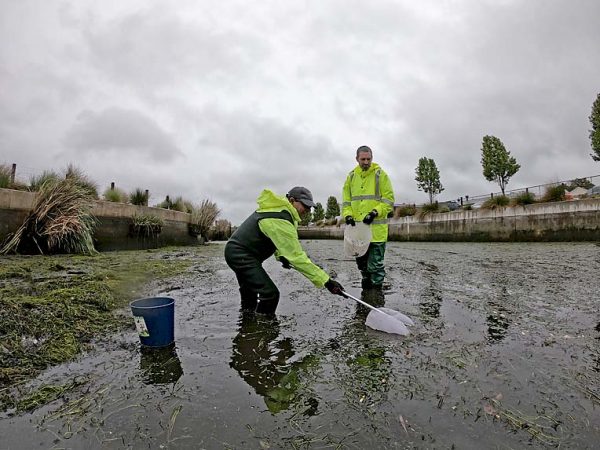

ENVIRONMENTAL officers and university researchers trudged through a large water catchment with nets at the Mount Gambier Railway Lands yesterday in an attempt to eradicate a pest fish.
Gambusia – a pest fish threatening the life of southern pygmy perch in the water body – was recently identified sparking action from the Mount Gambier City Council.
Environmental sustainability officer Aaron Izzard said it led to him contacting researchers from the University of Tasmania which has been working to eradicate the pest fish across Australia for several years.
“Initially the Southern Pygmy Perch were doing really well but after six months we found this other fish and were told it was gambusia,” Mr Izzard said.
“We first tried to get them out with bait traps, which eradicated about 4000 of them, but because they breed so rapidly, there were still a number in there,” Mr Izzard said.
“We contacted the University of Tasmania and that’s how we have ended up here now, trying to drain them out to get rid of them all.”
University of Tasmania, Institute for Marine and Antarctic Studies researcher Jahawar Patil led the project yesterday, which involved a physical manpower approach.
“We looked at the size of the catchment and we thought we would be able to get rid of the fish through physical efforts such as draining,” Mr Patil said.
Mr Izzard said the exercise involved trying to many of the Southern Pygmy Perch first, before dealing with the gambusia.
“We try and catch them to save them and take them to Grant High School who have an aquaculture system, then in a week or two we will put them back in,” he said.
“We move around where the water plants are and hope to scoop them up, which is easier when the water level is down.”
An expert in the field, Mr Patil said it was still difficult to establish exactly how the fish ended up in this catchment.
“The fish was brought into Australia with the hope it could control mosquito larvae, but it has spread right across the country and has become by far the most destructive pest, as it is present in almost every catchment,” Mr Patil said.
“It could have been brought by a number of factors, it could be human spread because even though they are listed as a pest, these tiny fish seem cute and people take them to different places.”





